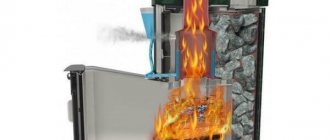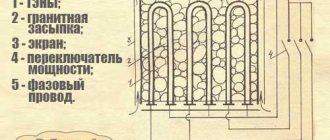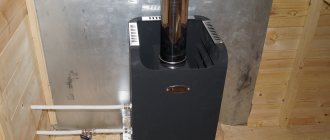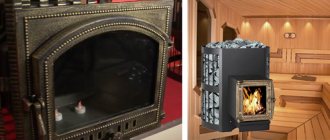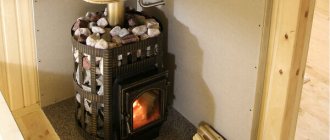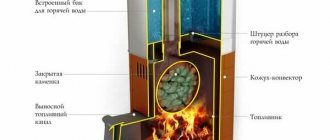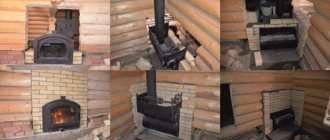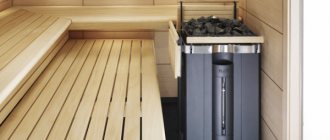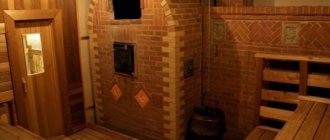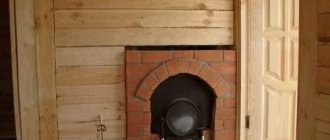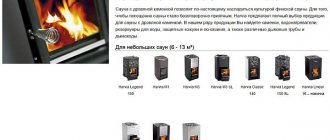Date of publication: June 17, 2020
Nowadays, stove and fireplace heating is one of the most effective and affordable solutions for heating cottages and country houses. After all, not everywhere in suburban conditions it is possible to connect to a gas main in order to organize gas heating. And types of fuel such as diesel, diesel fuel and especially electricity are often not economically profitable if it is necessary to heat the house on an ongoing basis.
Wood heating confidently holds a leading position in the suburban sector, because, in addition to warmth, it also brings comfort and a special atmosphere to the house, gathering entire families around a fireplace with burning wood.
In order for wood heating to be as efficient, long-lasting and economical as possible, it is important to choose the right stove for your home. A balanced selection of a model that will optimally combine all the required parameters for the specific tasks of a particular home will allow you to invest your money wisely and significantly increase the level of comfort of life.
When is it profitable to burn with wood?
It’s good when there is a gas main within reach of a country house. In this case, the question of choice does not arise for most owners; If wood heating is present, it is for comfort, in the form of a fireplace or a small decorative stove. If there is nothing to connect to and the house is large, the best choice would be a solid or liquid fuel boiler, since electric heating will cost much more and can only be considered as an additional (backup) option.
It’s another matter if the country house is small in area. For a building with two or three rooms and a kitchen, the number of heating methods is greater, but the most common is still the use of wood. In country cottages, wood heating is beneficial in the following cases:
- Seasonality of residence. Heating with wood is especially beneficial if people do not live in the house permanently, but use it for seasonal recreation. Even if there is a gas main nearby, it is not always cost-effective to carry gas.
Wall-mounted method of arranging a modern wood-burning stove for heating a house Source kamine-streubel.de
- Availability of fuel. If there are no problems with the procurement of firewood in the area, heating with wood will be the most economical way for a house of any size.
- Modern design. For a small house, a modern, economical wood-burning stove and well-designed heating will be the best solution.
The total area of the house and the footage of specific rooms requiring heating
The total footage of the building and the premises to which heat is required are fundamental when choosing furnace equipment. Based on the footage, the power of the product is selected. You can calculate the required power using a simple scheme: 1 kW of power is intended to heat an average of 10 square meters of space. It is worth noting that 10 square meters of room will be heated by 1 kW of stove power if the entire house has a good level of insulation. If the building is poorly insulated and is characterized by heat loss, you should choose a higher power fireplace.
Advice. You can most accurately select the required power taking into account the characteristics of the building with the help of a specialist who can correctly identify all the factors influencing this aspect.
Choosing the right thermal power is very important, since its lack will lead to poor heating levels, and excess power will create an unfavorable microclimate in the house and excessive load on the hearth, which can lead to its early breakdown.
Wise choice: what to look for
At different times in different countries there were many types of wood heating appliances. They differed in appearance, had different design features and purposes. Modern stoves for heating a home using wood can be classified in different ways:
- By appointment. Stoves can be heating, heating-cooking (then they have a hob and/or oven), special purpose (for example, for a sauna, greenhouse or garage).
- By brand. Models of both Russian and foreign production are available for sale. Among the latter are stoves from Poland, Canada, Sweden, France, Serbia, the Czech Republic and Belgium.
Hanging drop fireplace with a rotating firebox in hi-tech style Source pinterest.co.uk
- To size. Dimensions and weight can sometimes be critical.
- By location. It can be wall-mounted, corner, universal or island.
- According to the location and parameters of the chimney. Chimneys have different diameters and are located at the top, rear or top/rear.
- According to the material. The body is made of cast iron, steel, stone, brick, ceramics, tile (tile).
- According to the firebox material. The firebox is made of steel, cast iron, fireclay, vermiculite or ceramics.
- In terms of performance. The models are designed for different volumes (areas) of the heated room and have different thermal power (indicated in kW) and efficiency (from 50 to 95%).
- According to design features. There are models on the market with a fire-resistant glass or solid door, or with a water circuit (heat exchanger).
A brick heating and cooking stove conveys the atmosphere of country life. Source yandex.ru
When purchasing a wood-burning stove, pay attention to the defining parameters:
- Wall and firebox material. It is better if the stove is made of heat-resistant high-alloy steel, cast iron or black boiler steel. The walls of high-quality products are made thick (sometimes up to 8 mm) or lined with fireclay bricks.
- Economical. Long-burning designs (with a special firebox design and high efficiency) are on sale; Firewood is placed in them every 4-8 hours.
- Purpose. When choosing one design or another, you must remember that a free-standing stove will only heat the room in which it is installed; a wall-mounted stove will also heat adjacent ones (with a common wall). The sauna stove is equipped with a steam generator (a container for filling stones).
Design diagram with a long-burning water circuit Source xazovum.gezilam.ru.net
See also: Catalog of companies that specialize in insulating country houses.
Briefly about the main thing
It is difficult to say which stove is better for a bath - wood-burning or electric, brick or cast-iron. Everyone has their own preferences, and one bathhouse is not like another.
If we talk about solid fuel units, which are the most in demand, then their choice is based on several criteria. This is the power required for high-quality heating, the material of manufacture, the presence of a tank necessary for preparing hot water for washing.
The most important design feature is the location of the combustion chamber, which can be built-in or remote, allowing you to heat the bath not from the steam room, but from the dressing room.
True lovers of bathing procedures should pay attention to the type and volume of the heater, on which the quality of the steam depends.
A huge range of sauna stoves produced in our country and abroad allows you to find equipment that meets any requirements.
Ratings 0
Basic requirements for wood stoves
A properly selected stove must fulfill several conditions:
- Strength. The service life depends on the material and can range from 20 to 50 years (depending on the quality of workmanship and intensity of use).
- Economy. Economical fuel consumption is one of the priorities of choice.
- Compactness. An important parameter in a small house.
- Efficiency. Ideally, the stove should not only quickly warm up the house, but also maintain a comfortable temperature throughout the day.
- Safety. The stove, as a source of open flame, is subject to special fire safety requirements. The surface should not warm up above 90-95°C.
- Aesthetics. It’s great if the appearance of the stove complements and emphasizes the overall design of the house.
Fireplace stove with hob, Poland Source en.aviarydecor.com
Potbelly stove is not for bourgeois
The simplest version of the stove is the so-called “potbelly stove”, which became widespread at the beginning of the 20th century. This small and compact oven is cheap to manufacture and easy to operate. It was so popular because of the political cataclysms in the country: during the revolution and civil war, houses in large cities were not heated for several years, and people had no choice but to install small stoves at home.
Photo: Shutterstock.com
It was then that they got their nickname: the stoves were very “gluttonous” and only heated when the fire was burning in them. The premises were heated according to the “submarine” principle: in one of the rooms, usually the smallest, the windows and doors were caulked, and a metal pipe was installed through the window. Not only firewood was used as fuel, but often also furniture, noble libraries and parquet made of valuable wood.
Potbelly stoves found a second life already in the 1960s, with the beginning of the massive allocation of garden plots: most summer residents did not have the funds or the need to build a real stove in a small panel house, and therefore they were content with potbelly stoves. Gradually, their popularity began to decline due to the advent of electric heaters and new generation metal stoves.
Types of wood stoves
Currently, there are many types of wood stoves, the most common of which are:
- Traditional. They are built from brick or stone, and are considered not only durable, but also safe. These include the Russian stove, the Swedish stove, and the Dutch stove. Such structures heat the room slowly, but they also retain heat much longer than metal ones. Today there are practically no craftsmen left who know how to build a high-quality warm stove, and you also need to know how to use it. Therefore, they are rarely staged, mainly by adherents of antiquity or exoticism.
- Fireplace s. A classic fireplace is an open hearth that looks great in any setting. Spending an evening near it, watching the flames, is highly romantic, but not practical. A traditional fireplace does not cope well with high-quality heating of the room, but a modern fireplace stove does this much more efficiently.
Modern stove-fireplace made of cast iron Source otopleniehouse.ru
- Metal. In modern conditions, metal wood-burning home stoves are the most common option due to their low cost and ease of maintenance. They belong to the category of rapidly heating structures; The air temperature in the room rises within half an hour, but the wood burns out quickly.
- Furnaces with a water circuit. A water circuit is built into the furnace structure - a container with water and a pipe system connected to batteries. The heated gases give off heat to the water, which carries heat throughout the house. Such stoves are convenient because they can be installed anywhere in the house (where it is more convenient to build a chimney).
- Gas generators. Such designs are called long-burning furnaces. They are distinguished by compactness, high efficiency (from 80%) and a special design. The firebox consists of two chambers; In the first chamber, wood is burned, in the second, pyrolysis gas is accumulated and burned. There are several varieties on sale, including Buleryan, Professor Butakov’s stove, and Stropuva’s stove.
Manufacturing materials
The materials from which the hearth is made have a great influence on heating processes and heat generation. Many types of materials have the ability to accumulate heat and radiate it into the surrounding space, which is actively used by manufacturers of heat-generating equipment.
The following types of materials are used in the manufacture of furnace equipment:
- Cast iron
- Steel
- Boiler steel
- Ceramics
- Brick
- Chamotte
- Composite materials
- Tiles
- Soapstone chlorite
The body and main structural parts of the furnaces are made of metal, boiler steel and cast iron. The characteristics of steel and metal include the ability to heat up quickly, but also cool down quickly. Therefore, steel models are usually supplemented with a protective and heat-accumulating lining of the combustion chamber. Cast iron is distinguished as a powerful heat-accumulating material - yes, it takes a long time to heat up, but then it is capable of radiating thermal energy into the surrounding space for a long time.
Brick, fireclay, composite materials are usually used for lining the internal parts of the combustion chamber to enhance combustion processes, reflect heat from the walls of the firebox, increase the temperature level, fuel combustion efficiency and, as a result, enhance the heat generation process.
Ceramics and soapstone can also be used for lining the firebox, but are more often used for lining the outer body of stoves, along with tiles. These materials are characterized by the ability to accumulate heat and subsequently release it into the room, which enhances the overall thermal performance of the equipment. Cast iron and steel are also often used as body cladding.
Design and rules for placing the stove
Despite the variety of designs, all wood stoves produce energy to heat the air by burning wood. Therefore, they all consist of the same set of elements, which include:
- Firebox. Place where wood is burned, chamber made of heat-resistant materials.
- Grate (grid). Metal grate at the base of the firebox. Firewood is placed on it, air enters the firebox through it and ash is removed.
- Ash pan. A small chamber under the firebox where ash accumulates.
- Chimney. A pipe through which combustion gases are removed.
- Smoke damper. Blocks the chimney to retain heat.
Safe placement of an iron stove for a wood-burning home on a fireproof glass stand Source monitoruldevrancea.ro
Advantages and disadvantages
Using a wood-burning stove for home and garden (the modern version) in many cases has significant advantages:
- Easy to install and operate.
- Efficiency and economy. A high level of efficiency and careful consumption of firewood is ensured by various technological methods, from the shape of the exhaust pipe to the long-term burning mode.
- Quick effect of work. The heat from a working stove spreads quickly, a comfortable temperature is established within half an hour.
- Compactness. This quality is especially valuable in small country houses. Such a heating device can be installed in any room (if there is a chimney).
Video description
About the stove after two years of use in the following video:
- Multifunctionality. Modern models delight with thoughtful functionality. There are options that can switch to another fuel (coal or wood waste). Many models can be used not only for heating, but also for cooking or heating water.
- Safety. Properly installed (according to SNiP rules) stoves comply with all safety standards, regardless of design and material of manufacture. Many units have the ability to regulate the combustion or afterburning of gases.
- Appearance. A wood-burning stove can become a decoration for your home. Manufacturers offer options for interiors decorated in any style. You can purchase a model in a modern, strict and rational design, or in a national design, using spectacular details (even hand-painted tiles).
Tiles resistant to high temperatures Source versace-promo.ru
Steam source
There are two types of steam:
- Wet - appears when water boils. Additionally, a boiler is installed on the stove, which is filled with water. It heats up during combustion. It does not require a hot water supply system.
- Dry is considered the most beneficial for the body. To make it appear, you need to heat the stones to 500 degrees and pour water over them. The emerging steam does not increase the humidity level, but effectively warms up the steam room.
To create wet steam, it is not necessary to install a boiler with water. For this you can use an electric steam generator.
Wood stove prices
The secret to the popularity of wood-burning stoves lies in their wide capabilities and variety of offerings. On the market you can find both budget compact options and luxurious units that can decorate the most sophisticated interior. No matter how charming a stove may be, constantly throwing firewood into the firebox is a boring task, which is why more and more owners of country cottages prefer long-burning stoves.
A modern version of a traditional way of heating a home Source savoie-mont-blanc.com
If you look at average prices (in the Moscow region), they will look like this:
- Metal stoves. Heating: 5-16 thousand rubles. (depending on design). Heating and cooking: 9-35 thousand rubles. (domestic and imported). Stove-fireplace: 20-40 thousand rubles. (may have a stove and heat exchanger).
- Cast iron: From 20 to 120 thousand rubles, depending on the size and design.
- Stoves lined with tiles (tiles): 50-80 thousand rubles.
- Stone (from granite to Brazilian sandstone): 60-200 thousand rubles.
- With a water circuit: 20-55 thousand rubles.
- Long-burning stoves: 15-45 thousand rubles.
- Potbelly stove: 9-16 thousand rubles.
